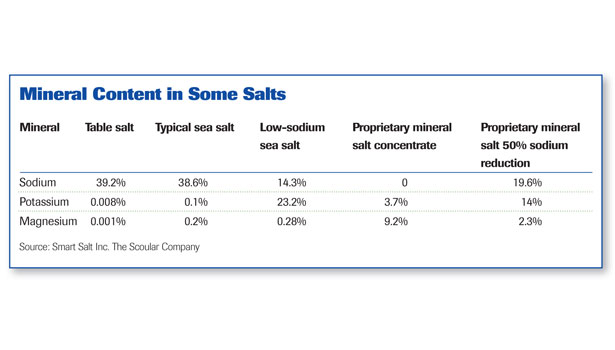 In order to reduce sodium in foods, a multi-dimensional approach must include preserving taste and technical function -- for starters. Presenters at Prepared Foods’ R&D Seminars helped illuminate the challenges, new approaches and new ingredient opportunities in this ever-growing category.
In order to reduce sodium in foods, a multi-dimensional approach must include preserving taste and technical function -- for starters. Presenters at Prepared Foods’ R&D Seminars helped illuminate the challenges, new approaches and new ingredient opportunities in this ever-growing category. Sodium and Health: Challenges and Opportunities
The evidence linking dietary salt to blood pressure has been exhaustively reviewed in scientific literature. Public health policy implications of the evidence have been considered by expert committees in many countries -- and by influential scientific bodies within such organizations as the World Health Organization.
“Overwhelmingly, the evidence supports the fact that, despite sodium being an essential mineral, current high intakes are not necessary and, for some, may increase the risk of hypertension. Salt reductions to 5-6g per day (2-2.4g sodium) are recommended,” explained Dr. Helen Mitchel, science director at Smart Salt Inc., and Deborah Rolf of The Scoular Company, in their presentation titled “Sodium and Health: The Evidence, Challenges and Opportunities.”
In 2006, a World Health Organization forum agreed that there is a strong scientific link between high salt consumption and a number of chronic diseases; that intervention programs repeatedly prove to be cost-effective; and that stakeholders (namely the food industry) must be involved in salt-reduction strategies to ensure success. A number of nations have taken steps to reduce sodium intake in their populations.
“Reducing salt in foods is a multi-dimensional task involving taste, technical function and preservation. Several approaches have been used, including adaptation, receptor stimulation, multi-sensory principles, salt substitutes and salt boosters,” they explained.
Adaptation, the simplest solution, is to add less sodium chloride with no other changes. This strategy is valid only if the salt concentration exceeds that required for all of its functionalities (taste, preservation, appearance, texture). If this strategy is deployed over several years, the consumer may not perceive a difference. Care must be taken to ensure that the consumer does not run into the taste threshold.
Current approaches to salt reduction include emulsion technology, which provides ways to optimize salt-receptor stimulation. Multiple emulsions, consisting of water droplets dispersed in fat droplets and then dispersed in another outer layer of water containing salt, have been shown to have this effect. The inner layer of water can be sodium-free and replace some of the volume of the product–requiring less of the outer, salted aqueous phase. As a result, the consumer enjoys the salt taste of the outer aqueous phase while consuming less total sodium.
Changing the crystal structure of salt may also produce the salt taste, with reduced amounts of salt. Reducing the particle size also improves dissolution rate and thereby increases salt taste perception.
Other approaches to sodium reduction include using multi-sensory principles, salt substitutes and the use of salt boosters -- including umami flavor enhancers, monosodium glutamate (MSG), inosates, ribonucleotides, HVPs and yeast extracts. Often, multiple approaches are used in product development to optimize sodium reduction.
However, it has been shown that optimized blends of a proprietary mineral salt high in magnesium chloride, plus items in the tool kit—such as other minerals, umami ingredients and sea salt—allow for sodium reductions up to 60%. Matching the taste profile and salty flavor of regular salt is the trick.
A proprietary mineral salt solution high in magnesium chloride is able to provide all the functional properties of salt and an improved mineral balance. In addition, a DBPC clinical study at the University of Kuopio, Finland, conducted April-July 2009, showed that substitution of proprietary mineral salt for regular salt in subjects with high, normal or mildly elevated blood pressure effectively reduced their daily sodium intake, accompanied by significant lowering of systolic blood pressure. The proprietary mineral salt promoted good dietary compliance because of the indistinguishable industrial food products containing it, including salami, frankfurters, bread, cheese, meatballs, casseroles, soups, pasta and pizzas.
“Sodium and Health: The Evidence, Challenges and Opportunities,”
Deborah Rolf, The Scoular Company
Deborah.rolf@smartstart.com;
and Dr. Helen Mitchell, science director, Smart Salt Inc.
-- Summary by Elizabeth Pelofske, Contributing Editor
Novel HVP
A novel, acid-hydrolyzed vegetable protein (HVP), Vegamine AT, was the topic of a Prepared Foods’ R&D Seminar presentation titled “New Novel Ingredient: Low-sodium/High-enhancement HVPs,” given by Dr. Dafne Diez de Medina, Ph.D., vice president, Innovation, Research & Development, Innova Flavors.
HVPs are a single or combination of plant proteins that have been hydrolyzed (digested) and neutralized, resulting in a combination of smaller peptides and amino acids. HVPs are used in food applications as flavoring agents and enhancers, yielding non-characterizing meaty and chicken flavor (chicken- or beef-like) profiles. As a flavor enhancer, HVPs are useful for their relatively high salt and MSG content.
HVPs have been a valuable tool for food manufacturers for over 100 years as a cost-effective ingredient and the “backbone” for numerous applications, such as soups, sauces and gravies, side dishes, snacks, main meals, marinades, rubs and sprinkle-on uses. However, there is an urgent need to lower an excessively high sodium intake in the diet. The “Dietary Guidelines for Americans 2010” recommends a general reduction of daily sodium intakes from 2,300mg to 1,500mg per day.
Common ingredients that are added to HVP require labeling and include disodium inosinate, disodium guanylate maltodextrin, salt, MSG and color. HVPs need to be labeled by protein source.
Innova offers proprietary HVPs that comply with a 3-MCPD (a recognized carcinogenic compound) level of <1ppm, as per U.S. requirements. Using an innovative process, a series of low-sodium alternatives based on KCI have been developed. The line—Vegamine AT—can support cost-reduction initiatives. Vegamine AT can increase natural enhancement; facilitate flavor creation due to higher protein levels; and can be used to extend or partially replace higher-cost ingredients—such as AYE and meat powders. Product characteristics including reductions in MSG and salt content were further described in the presentation.
In oyster crackers, using Vegamine AT in the coating system provides an overall enhanced flavor profile, and when used in the coating system, can achieve significant levels of sodium reduction. Similar results are noted for seasoned potato chips and soups. Vegamine AT applications used in chicken bouillon can result in a 25-30% sodium reduction for less than $0.01/serving. Additionally, the use of AYE can be lowered by 50% while achieving an 8% sodium reduction.
Sodium reductions of 20-25% were reported for chicken and beef gravies. In an Italian couscous, the use of Vegamine AT results in a 20% + sodium reduction with 1:1 replacement or a 25% sodium reduction optimized with a 25% reduction in HVP usage.
Vegamine AT offers a valuable tool for the food developer in need of increased flexibility when formulating and supports sodium-reduction initiatives with cost reductions and formula optimization. Additionally, the novel ingredient series offers an HVP option with significant improvement over potassium chloride-based products that often are bitter-tasting with limited usage.
“New Novel Ingredient: Low-sodium/High-enhancement HVPs,”
Dafne Diez de Medina, Ph.D., vice president, Innovation, Research & Development
Innova Flavors, 630-929-4850, ddiezdemedina@innovaflavors.com, www.innovaflavors.com
-- Summary by Kelley Fitzpatrick, Contributing Editor
Clean Label, Reduced-sodium, High-taste-impact Foods
Nearly four in 10 Americans continue to believe that low-sodium products do not taste as good as their high-salt counterparts, according to data from IFIC and presented by Dr. Sree Raghavan of DSM Food Specialities Inc. at Prepared Foods’ R&D Seminar titled “Developing Clean Label, Reduced Sodium, High Taste Impact Foods.” Further, according to current recommendations, hypertensive individuals, African Americans, and middle-aged and older adults (70% of the U.S. population) would benefit from reducing their sodium intake from 2,300mg to 1,500mg per day -- a further 35% reduction or the equivalent of removing two thirds of the salt from the current diet. Given the current U.S. marketplace and the resulting excessively high sodium intake, it will be challenging to achieve the lower recommended level.
Many nations, such as the U.S., EU, Japan and Australia, impose strict regulatory guidelines when such claims are made for foods sold in their respective regions. Such requirements create a demand for natural products that provide clean and simple labels while meeting regulatory conditions, such as reduced sodium, natural and label simplicity. DSM’s Yeast Extracts (YE) and YE-based process flavors fit all these requirements.
YE and YE-based process flavors create formulation flexibility, due to their concentration levels and purity, while being soy-/gluten-free and vegetarian. Developed naturally through the enzymatic hydrolysis of proteins, this process yields various peptide and amino acid profiles that provide a natural way of enhancing and enriching the taste of savory foods (bouillon-broth taste). In addition, nucleotides are present as natural taste enhancers or synergistically work with peptides to provide a strong umami taste boost. YEs also naturally contain organic acids and other taste ingredients that deliver flavor and flavor-enhancement impact to many foods. An added benefit from YE occurs when Maillard reactions are promoted between naturally occurring reducing sugars and amino acids -- to deliver products with specific taste directions, including beef, chicken, roast, garlic, roasted spice and onion tastes.
DSM process flavors formulated from a yeast extract and vegetable base, such as garlic and onion, provide up to five times the strength of a standard, commercially available equivalent product in the market. This offers creative flexibility for developers to add or adjust other ingredients in the formulation, while concurrently promoting a “flavor burst” impact. These ingredients also offer potential cost-in-use savings and the freedom to formulate, due to their low dose rates.
As a proprietary technology, unique reaction conditions for flavor creation with possibilities for unique flavor impact are possible. YE-Vegetable process flavors are stable in most food-processing conditions and formulations, including retort processing. Production consistency offers low batch-to-batch variation, as well as reliable and trustworthy taste tonalities.
DSM’s Baker’s Yeast extracts, with taste contributions from amino acids, nucleotides, phospholipids and glycoproteins, also deliver unique, versatile, flavor-extending and mild, fatty flavor direction. Such YEs offer moisture retention qualities for improved mouthfeel and juiciness for use in a wide range of finished applications, including meat and dairy systems.
YE and YE Process Flavors offer numerous advantages, including delivering savory taste donation, flavor promotion and natural taste enhancement. These ingredients are ideally suited for label and ingredient simplification challenges. With sodium-reduction strategies, DSM’s YE-based ingredients promote salt flavor enhancement while restoring key flavor qualities of foods formulated with lower sodium.
“Developing Clean Label, Reduced Sodium, High Taste Impact Foods,”
Dr. Sree Raghavan, senior technical services manager, DSM Food Specialties
908-391-9498, sree.raghavan@dsm.com, www.dsm.com
-- Summary by Kelley Fitzpatrick, Contributing Editor
